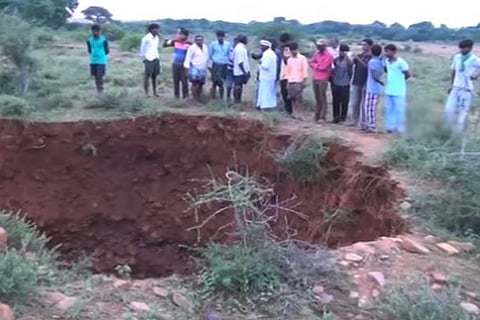

Following heavy rainfall in Andhra Pradesh recently, many sinkholes have been forming in the Rayalaseema region, mainly in Kadapa district.
According to Prabhakar Reddy, the sarpanch of Buggalapalle village in Chintakommadinne mandal, sinkholes have been forming in the area for the past few years.
"On Monday, two sinkholes formed near Buggamaleswara temple in our village. Last year, we saw nearly 20 sink holes form in the span of two week in our, as well as surrounding villages," he said.
Prabhakar also claimed the in the past three years, 250 sinkholes have been found in the villages surrounding the Buggavagu project. Buggavagu is a minor irrigation project which caters to 10 villages including Buggalapalle and Gudavandlapalle.
"We have informed the officials and they said the sinkholes are being formed due to the loosening of the soil," he stated.
Residents have reported hearing some sounds when the sinkholes appear. The sizes of these can be as big as 10 feet wide and seven feet deep and, at times, can even be larger.
While not a new phenomenon, farmers are skeptical to go to their farms with a surge in sinkholes.
"This is not first time that such holes are forming in the ground, but whenever this happens we are scared to go to the fields," said Nagendar Reddy, a farmer in Buggalapally.
In 2015, The Hindu reported, a farmer in Kadapa district found a sinkhole which was 20 feet in diameter. Three sinkholes of the similar size were formed in a banana plantation in Takkoli Lakshmipathi Reddy, engulfing around 40 plants.
In the November of 2015, geological experts visited Chintakomma Dinne (CK Dinne) mandal where many sinkholes had formed. Prabakar Reddy said that the experts who came to examine the spot suggested that the ditches be filled with sand and concrete mix.
During a visit to one of the affected areas, Anand Pandey, a scientist with the National Geophysical Research Institute, Hyderabad, said, "Our observation suggest that the lower catchment area of the Buggavagu project contains large parts of soft minerals suchas limestone, dolomite. When water flows through the soil, along with an increase in ground water level, it puts pressure on those minerals due to which they melt and collapse. As this happens underground, we cannot exactly predict where the next sinkhole will form".
James Vincent explains in the Independent, "Sinkholes mainly occur in what is known as 'karst terrain'; areas of land where soluble bedrock (such as limestone or gypsum) can be dissolved by water. With cover-subsidence sinkholes the bedrock becomes exposed and is gradually worn down over time, with the holes often becoming ponds as the water fills them in."